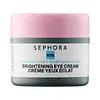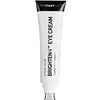What's inside
What's inside
 Key Ingredients
Key Ingredients

 Benefits
Benefits

 Concerns
Concerns

 Ingredients Side-by-side
Ingredients Side-by-side

Water
Skin ConditioningCaprylic/Capric Triglyceride
MaskingGlycerin
HumectantGlyceryl Stearate Citrate
EmollientHeptyl Undecylenate
EmollientButylene Glycol
HumectantSilica
AbrasiveJojoba Esters
EmollientC10-18 Triglycerides
EmollientHydroxyethyl Acrylate/Sodium Acryloyldimethyl Taurate Copolymer
Emulsion StabilisingCaffeine
Skin ConditioningSodium Polyacrylate
AbsorbentHydroxyacetophenone
AntioxidantTocopheryl Acetate
AntioxidantCaprylyl Glycol
EmollientSodium Hyaluronate
HumectantPolysorbate 60
EmulsifyingSorbitan Isostearate
EmulsifyingPotassium Cetyl Phosphate
EmulsifyingSodium Benzoate
MaskingChlorella Vulgaris Extract
Skin ConditioningSodium Phytate
Tocopherol
AntioxidantWater, Caprylic/Capric Triglyceride, Glycerin, Glyceryl Stearate Citrate, Heptyl Undecylenate, Butylene Glycol, Silica, Jojoba Esters, C10-18 Triglycerides, Hydroxyethyl Acrylate/Sodium Acryloyldimethyl Taurate Copolymer, Caffeine, Sodium Polyacrylate, Hydroxyacetophenone, Tocopheryl Acetate, Caprylyl Glycol, Sodium Hyaluronate, Polysorbate 60, Sorbitan Isostearate, Potassium Cetyl Phosphate, Sodium Benzoate, Chlorella Vulgaris Extract, Sodium Phytate, Tocopherol
Water
Skin ConditioningDimethicone
EmollientCoco-Caprylate/Caprate
EmollientGlycerin
HumectantCaprylic/Capric Triglyceride
MaskingGlyceryl Stearate
EmollientCandelilla/Jojoba/Rice Bran Polyglyceryl-3 Esters
EmulsifyingPunica Granatum Seed Oil
EmollientEthylhexyl Palmitate
EmollientMica
Cosmetic ColorantPhenoxyethanol
PreservativeCetearyl Alcohol
EmollientSodium Stearoyl Lactylate
EmulsifyingBenzyl Alcohol
PerfumingPolysilicone-11
Hydroxyacetophenone
AntioxidantSodium Stearoyl Glutamate
CleansingTocopheryl Acetate
AntioxidantAcrylates/C10-30 Alkyl Acrylate Crosspolymer
Emulsion StabilisingSodium Gluconate
Skin ConditioningEthylhexylglycerin
Skin ConditioningSilica
AbrasiveDehydroacetic Acid
PreservativeDiglucosyl Gallic Acid
Sodium Hydroxide
BufferingTrihydroxystearin
Skin ConditioningTin Oxide
AbrasiveSodium Hyaluronate
HumectantGlucomannan
Skin ConditioningCI 77891
Cosmetic ColorantWater, Dimethicone, Coco-Caprylate/Caprate, Glycerin, Caprylic/Capric Triglyceride, Glyceryl Stearate, Candelilla/Jojoba/Rice Bran Polyglyceryl-3 Esters, Punica Granatum Seed Oil, Ethylhexyl Palmitate, Mica, Phenoxyethanol, Cetearyl Alcohol, Sodium Stearoyl Lactylate, Benzyl Alcohol, Polysilicone-11, Hydroxyacetophenone, Sodium Stearoyl Glutamate, Tocopheryl Acetate, Acrylates/C10-30 Alkyl Acrylate Crosspolymer, Sodium Gluconate, Ethylhexylglycerin, Silica, Dehydroacetic Acid, Diglucosyl Gallic Acid, Sodium Hydroxide, Trihydroxystearin, Tin Oxide, Sodium Hyaluronate, Glucomannan, CI 77891
 Reviews
Reviews

Ingredients Explained
These ingredients are found in both products.
Ingredients higher up in an ingredient list are typically present in a larger amount.
This ingredient is an emollient, solvent, and texture enhancer. It is considered a skin-softener by helping the skin prevent moisture loss.
It helps thicken a product's formula and makes it easier to spread by dissolving clumping compounds.
Caprylic Triglyceride is made by combining glycerin with coconut oil, forming a clear liquid.
While there is an assumption Caprylic Triglyceride can clog pores due to it being derived from coconut oil, there is no research supporting this.
Learn more about Caprylic/Capric TriglycerideGlycerin is already naturally found in your skin. It helps moisturize and protect your skin.
A study from 2016 found glycerin to be more effective as a humectant than AHAs and hyaluronic acid.
As a humectant, it helps the skin stay hydrated by pulling moisture to your skin. The low molecular weight of glycerin allows it to pull moisture into the deeper layers of your skin.
Hydrated skin improves your skin barrier; Your skin barrier helps protect against irritants and bacteria.
Glycerin has also been found to have antimicrobial and antiviral properties. Due to these properties, glycerin is often used in wound and burn treatments.
In cosmetics, glycerin is usually derived from plants such as soybean or palm. However, it can also be sourced from animals, such as tallow or animal fat.
This ingredient is organic, colorless, odorless, and non-toxic.
Glycerin is the name for this ingredient in American English. British English uses Glycerol/Glycerine.
Learn more about GlycerinHydroxyacetophenone is antioxidant with skin conditioning and soothing properties. It also boosts the efficiency of preservatives.
This ingredient is not irritating or sensitizing.
Silica, also known as silicon dioxide, is a naturally occurring mineral. It is used as a fine, spherical, and porous powder in cosmetics.
Though it has exfoliant properties, the function of silica varies depending on the product.
The unique structure of silica enhances the spreadability and adds smoothness, making it a great texture enhancer.
It is also used as an active carrier, emulsifier, and mattifier due to its ability to absorb excess oil.
In some products, tiny microneedles called spicules are made from silica or hydrolyzed sponge. When you rub them in, they lightly polish away dead skin layers and enhance the penetration of active ingredients.
Learn more about SilicaSodium Hyaluronate is hyaluronic acid's salt form. It is commonly derived from the sodium salt of hyaluronic acid.
Like hyaluronic acid, it is great at holding water and acts as a humectant. This makes it a great skin hydrating ingredient.
Sodium Hyaluronate is naturally occurring in our bodies and is mostly found in eye fluid and joints.
These are some other common types of Hyaluronic Acid:
Learn more about Sodium HyaluronateTocopheryl Acetate is AKA Vitamin E. It is an antioxidant and protects your skin from free radicals. Free radicals damage the skin by breaking down collagen.
One study found using Tocopheryl Acetate with Vitamin C decreased the number of sunburned cells.
Tocopheryl Acetate is commonly found in both skincare and dietary supplements.
Learn more about Tocopheryl AcetateWater. It's the most common cosmetic ingredient of all. You'll usually see it at the top of ingredient lists, meaning that it makes up the largest part of the product.
So why is it so popular? Water most often acts as a solvent - this means that it helps dissolve other ingredients into the formulation.
You'll also recognize water as that liquid we all need to stay alive. If you see this, drink a glass of water. Stay hydrated!
Learn more about Water